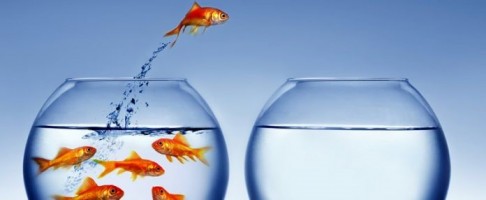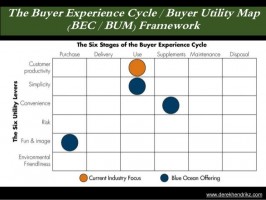Blue Ocean Thinking – Creating Innovative Public Policy
The views expressed are those of the author and do not necessarily reflect the views of ASPA as an organization.
By Bill Brantley
October 16, 2017
I first read Blue Ocean Strategy when the book came out in 2005. The thesis by W. Chan Kim and Renee Mauborgne was a simple argument: instead of companies competing in established markets (“red oceans”), companies should create markets (“blue ocean”). The metaphors red ocean and blue ocean were chosen because red oceans summon up images of companies fiercely competing with each for market dominance. Much like sharks fighting over a school of fish.
In contrast, blue oceans are wide open spaces where a company can build a market free of competing companies. Using various tools, such as the Strategy Canvas, companies can discover unrealized opportunities and new customers while designing innovative services and products. An early example of the blue ocean strategy was Cirque Du Soleil. Kim and Mauborgne describe how Cirque Du Soleil built a new market model that avoided the competitive traditional circus marketplace. How Cirque Du Soleil and other blue ocean companies build new business models is described in the next two sections.

The Four Actions Framework
Kim and Mauborgne advise companies to build a Strategy Canvas in which companies determine the competitive factors in the current marketplace. Then, using the Four Actions Framework, a company determines which factors to reduce or eliminate while creating new competitive factors and raising existing factors. For Cirque Du Soleil, the organization eliminated the traditional circus animals while raising the level of acrobatics. Cirque Du Soleil created the competitive factor of an overarching story to unite the acts into a mesmerizing performance. So, what guided Cirque Du Soleil in deciding which factors to eliminate, reduce, raise or create?
Mapping the Buyer Experience Cycle Through the Buyer Utility Map
Companies map the buyer experience cycle to discover new customers and develop new services and products. Kim and Mauborgne explain there are six stages in the buyer experience cycle: purchase, delivery, use, supplements, maintenance and disposal. Imagine the six stages as columns in a table. The rows are the Six Utility Layers: customer productivity, simplicity, convenience, risk reduction, fun and image, and environmental friendliness. The completed map will have 36 cells in which a company can place a customer pain point.

A French company, Groupe SEB, created a novel electric home french-fry maker using the Buyer Utility Map. Groupe SEB found that current French-fry makers were dangerous because of the hot oil needed to cook the french-fries. The hot oil also required inconvenient waste disposal of the used oil which also made cleaning the fryer difficult. Groupe SEB eliminated the oil issue by creating a french-fry cooker that used baking to make oil-free and healthier french-fries. The blue ocean thinking tools and methods allowed Groupe SEB to leap ahead of their competitors and dominate a crowded marketplace.
What Does the Blue Ocean Strategy Have to Do with Public Policy?
All of the above is great for companies, but how can the Blue Ocean Strategy help public agencies? In the Epilogue to Kim and Mauborgne’s latest book, Blue Ocean Shift (2017), the authors describe how Malaysia created a nonprofit research institute to create blue ocean policy initiatives. First established in 2008, the Malaysia Blue Ocean Strategy Institute has hosted government summits for Malaysian public officials and selected private sector leaders. The purpose of the summits is to create economic and social blue ocean initiatives.
Kim and Mauborgne write that the blue ocean strategies and tools help government agencies successfully execute national strategies. The authors explain blue ocean thinking helps break down government silos, reduces governmental agency turf wars and encourages agencies to share information and resources to achieve blue ocean innovations. Blue ocean thinking also encourages innovative policymaking that would be hard to produce by conventional policy analysis methods.
One example of an innovative policy is Malaysia’s Community Rehabilitation Program (CRP). The CRP was created to rehabilitate petty criminals. Before the CRP, the traditional government policy was to incarcerate prisoners in large prisons while severely limiting contact between the prisoners and their families. CRP housed prisoners in spare space on military facilities and allowed for extensive contact between the prisoners and their families. Recidivism has decreased while CRP centers are 85 percent cheaper to build and 58 percent cheaper to run. The Malaysian government estimates that CRP will save taxpayers $1 billion (US dollars) in its first ten years.
Blue Ocean Policy Analysis and Making
The lessons from Malaysia’s experiments with blue ocean thinking demonstrates the great value of Kim and Mauborgne’s ideas. What I especially like are the two tools: The Buyer Utility Map and the Four Factor Model. Think of the citizen journey and which factors matter most to citizens. Thinking blue ocean helps to create innovative policy ideas that go beyond the tired red ocean government policies.
Author: Bill Brantley teaches at the University of Maryland (College Park) and the University of Louisville. He also works as a Federal employee for the U.S. Patent and Trademark Office. All opinions are his own and do not reflect the opinions of his employers. You can reach him at http://billbrantley.com.




 (2 votes, average: 5.00 out of 5)
(2 votes, average: 5.00 out of 5)
 Loading...
Loading...
Blue Ocean Thinking – Creating Innovative Public Policy
The views expressed are those of the author and do not necessarily reflect the views of ASPA as an organization.
By Bill Brantley
October 16, 2017
I first read Blue Ocean Strategy when the book came out in 2005. The thesis by W. Chan Kim and Renee Mauborgne was a simple argument: instead of companies competing in established markets (“red oceans”), companies should create markets (“blue ocean”). The metaphors red ocean and blue ocean were chosen because red oceans summon up images of companies fiercely competing with each for market dominance. Much like sharks fighting over a school of fish.
In contrast, blue oceans are wide open spaces where a company can build a market free of competing companies. Using various tools, such as the Strategy Canvas, companies can discover unrealized opportunities and new customers while designing innovative services and products. An early example of the blue ocean strategy was Cirque Du Soleil. Kim and Mauborgne describe how Cirque Du Soleil built a new market model that avoided the competitive traditional circus marketplace. How Cirque Du Soleil and other blue ocean companies build new business models is described in the next two sections.
The Four Actions Framework
Kim and Mauborgne advise companies to build a Strategy Canvas in which companies determine the competitive factors in the current marketplace. Then, using the Four Actions Framework, a company determines which factors to reduce or eliminate while creating new competitive factors and raising existing factors. For Cirque Du Soleil, the organization eliminated the traditional circus animals while raising the level of acrobatics. Cirque Du Soleil created the competitive factor of an overarching story to unite the acts into a mesmerizing performance. So, what guided Cirque Du Soleil in deciding which factors to eliminate, reduce, raise or create?
Mapping the Buyer Experience Cycle Through the Buyer Utility Map
Companies map the buyer experience cycle to discover new customers and develop new services and products. Kim and Mauborgne explain there are six stages in the buyer experience cycle: purchase, delivery, use, supplements, maintenance and disposal. Imagine the six stages as columns in a table. The rows are the Six Utility Layers: customer productivity, simplicity, convenience, risk reduction, fun and image, and environmental friendliness. The completed map will have 36 cells in which a company can place a customer pain point.
A French company, Groupe SEB, created a novel electric home french-fry maker using the Buyer Utility Map. Groupe SEB found that current French-fry makers were dangerous because of the hot oil needed to cook the french-fries. The hot oil also required inconvenient waste disposal of the used oil which also made cleaning the fryer difficult. Groupe SEB eliminated the oil issue by creating a french-fry cooker that used baking to make oil-free and healthier french-fries. The blue ocean thinking tools and methods allowed Groupe SEB to leap ahead of their competitors and dominate a crowded marketplace.
What Does the Blue Ocean Strategy Have to Do with Public Policy?
All of the above is great for companies, but how can the Blue Ocean Strategy help public agencies? In the Epilogue to Kim and Mauborgne’s latest book, Blue Ocean Shift (2017), the authors describe how Malaysia created a nonprofit research institute to create blue ocean policy initiatives. First established in 2008, the Malaysia Blue Ocean Strategy Institute has hosted government summits for Malaysian public officials and selected private sector leaders. The purpose of the summits is to create economic and social blue ocean initiatives.
Kim and Mauborgne write that the blue ocean strategies and tools help government agencies successfully execute national strategies. The authors explain blue ocean thinking helps break down government silos, reduces governmental agency turf wars and encourages agencies to share information and resources to achieve blue ocean innovations. Blue ocean thinking also encourages innovative policymaking that would be hard to produce by conventional policy analysis methods.
One example of an innovative policy is Malaysia’s Community Rehabilitation Program (CRP). The CRP was created to rehabilitate petty criminals. Before the CRP, the traditional government policy was to incarcerate prisoners in large prisons while severely limiting contact between the prisoners and their families. CRP housed prisoners in spare space on military facilities and allowed for extensive contact between the prisoners and their families. Recidivism has decreased while CRP centers are 85 percent cheaper to build and 58 percent cheaper to run. The Malaysian government estimates that CRP will save taxpayers $1 billion (US dollars) in its first ten years.
Blue Ocean Policy Analysis and Making
The lessons from Malaysia’s experiments with blue ocean thinking demonstrates the great value of Kim and Mauborgne’s ideas. What I especially like are the two tools: The Buyer Utility Map and the Four Factor Model. Think of the citizen journey and which factors matter most to citizens. Thinking blue ocean helps to create innovative policy ideas that go beyond the tired red ocean government policies.
Author: Bill Brantley teaches at the University of Maryland (College Park) and the University of Louisville. He also works as a Federal employee for the U.S. Patent and Trademark Office. All opinions are his own and do not reflect the opinions of his employers. You can reach him at http://billbrantley.com.
Follow Us!